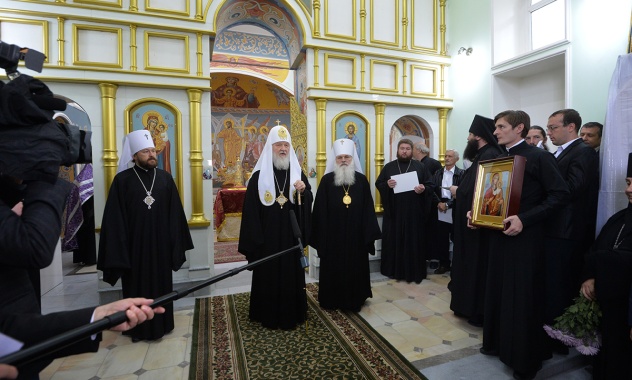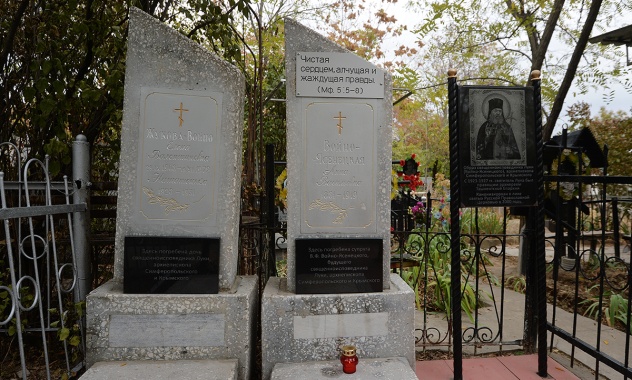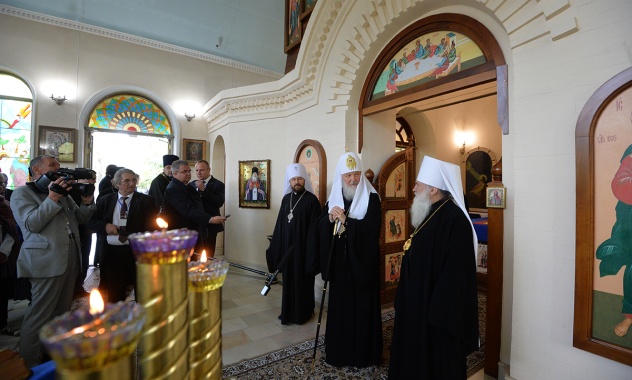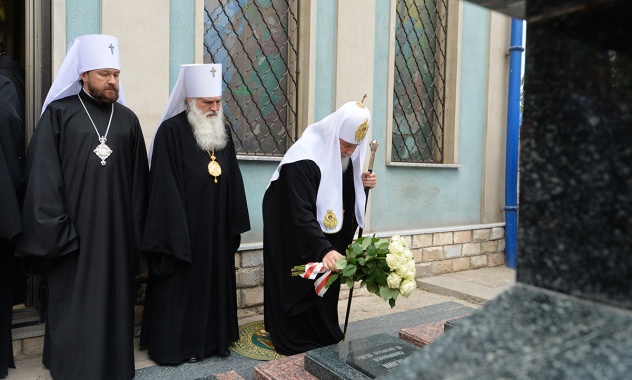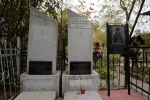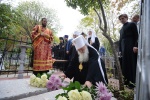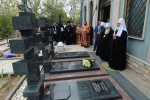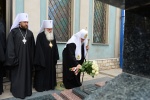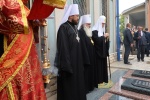Patriarch Kirill Visits Botkin Cemetery in Tashkent
October 2, 2017 – His Holiness Patriarch Kirill of Moscow and All Russia visited the First City Cemetery in Tashkent more known as the cemetery on Botkin Street or Botkin Cemetery.
The Primate of the Russian Orthodox Church was accompanied by Metropolitan Vekentiy of Tashkent and Uzbekistan, head of the Metropolia of Central Asia, Metropolitan Hilarion of Volokolamsk, head of the Department for External Church Relations, Archbishop Sergiy of Solnechnogorsk, head of the Moscow Patriarchate administrative secretariat, V. Tryudnev, Russian ambassador to Uzbekistan, V. Legoida, head of the Moscow Patriarchate synodal department of the Church’s relations with society and mass media, and Rev. Alexander Volkov, head of the Patriarchal press service.
His Holiness visited the church of the Most Orthodox Prince Alexander Nevsky built in 1902-1905. It is one of the three churches which functioned in Tashkent in the Soviet time.
At the church, His Holiness was welcomed by the rector of the St. Alexander Nevsky church, Archpriest Sergiy Statsenko, and the Tashkent clergy.
Patriarch Kirill addressed those present, saying,
‘Your Eminences; dear brothers and sisters:
I am very glad to visit the historic church of St. Alexander Nevsky at the Botkin Cemetery in Tashkent in which more than one generation of the Russian Orthodox people have been buried and which in itself is a monument to the presence of our people in this land. Among those who are buried here are outstanding people who worked in various areas of knowledge and social work and simply brilliant personalities associated with the history of the Russian presence in Tashkent.
When we come in touch with the past, even looking at the graves, we always experience something important going on in our consciousness. First, each one understands that he will be buried too. ‘There is no man which sinneth not’, and there is no one who would escape death. This is why the contemplation of graves and a prayer at a cemetery is always important for those who pray, for nothing brings us as closely in touch with eternity as death.
Sometimes people are afraid of death. They protect their children from seeing the dead and do not like to speak about it. It results from unbelief, from one’s excessive attachment to this life and reluctance to think about the future. Whereas a believer must think about the future because the future life is the goal of our earthly life, and to reach the Kingdom of God we must live in such a way that after the death the good gates of eternity may open before us.
The Church cherishes the memory of the deceased by celebrating requiem services, which are especially solemn on the Days of the Dead. We must remember our previous generations; we must pray for our parents and for all those who we remember in the line of our relatives and loved ones who were before us. And we should certainly always think about our own life.
May the Lord preserve all of you and strengthen the faith in your heart and the memory of the previous generations’.
His Holiness presented the church of St. Alexander Nevsky in the Botkin Cemetery with a copy of the Icon of Our Lady of Smolensk.
After his visit to the cemetery, Patriarch Krill laid flowers at the grave of relatives of St. Luka (Voino-Yasenetsky). In 1919, the future saint V. A. Voino-Yasenetsky buried his wife near the church of St. Alexander Nevsky, Anna Vasilyevna Lanskaya. In 1931, a small girl by name of Natashenka, St. Luka’s granddaughter was buried next to his wife’s grave, and in 1972 his only daughter Yelena was buried there. At present, there are modest gravestones placed on their graves. His Holiness Kirill also came to the grave of Archimandrite Boris (Kholchev, 1895-1971).
Then Patriarch Kirill visited the Chapel of Our Lady the Joy to All the Afflicted built in the early 70s of the 19th century, soon after the cemetery emerged in that territory. In the beginning of the 20th century 20s, after the church of St. Alexander Nevsky was captured by the Renovators, the Orthodox parishioners had to celebrate in this chapel. Close to it are graves of outstanding clergy of the Diocese of Tashkent and Uzbekistan – Metropolitans Arseniy (Stadnitsky, d. 10 February 1036), Nikandr (Fenomenov, d. 18 February 1933) and Archbishop Gabriel (Ogorodnikov, d. 28 February 1971).
Addressing the congregation, His Holiness said that he visited the place with a special feeling as it ‘preserved the canonical Orthodoxy and was the place in which lie those who refused to accept the schismatic Renovators in spite of the fact that they were supported by the authorities who used force to extrude the faithful’.
‘In this place divine services were celebrated under a tent until the Renovation heresy and schism collapsed. We should cherish the memory of the courage of our predecessors who in a severe situation preserved their faithfulness to canonical Orthodoxy and prayed for Patriarch Tikhon and never betrayed the Russian Church.
‘And today, in this difficult time, the unity of the Church is an indispensable guarantee of the preservation of the unity of our people. Without the unity of the Church it is difficult to speak about a true unity of the people. And if the people are divided, the state loses its power as well. May the Lord preserve us all in unanimity and steadfast Orthodox faith’, he said.
Patriarch Kirill presided over the requiem service for the deceased archapstors and clergy of the diocese of Tashkent. After flowers were laid at the graves of the Tashkent bishops, ‘Eternal Memory’ was sung to them.
Then Patriarch Kirill visited the synodal administrative center of the Metropolia of Central Asia.
It was built on the basis of the old diocesan administrative building, the residence of the ruling bishops of the diocese of Tashkent. This place in the center of the city was bought out from the state in the mid-1940s. For a long time the building was left without repair and dilapidated with time. In 2012 it was decided to demolish the single-storey buildings. In January 2013 the first stone was laid in the foundation of a new two-storey building and later it was decided to give it to the synodal administrative center for the Synod of the Metropolia of Central Asia to hold its sessions in it. This building also serves as a hotel for bishops coming to Tashkent for the Synod’s meetings.
After the inspection of the synodal center, His Holiness Patriarch Kirill went from Tashkent to Bokhara.
Patriarchal Press Service
DECR Communication Service








